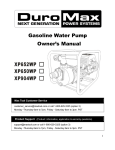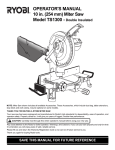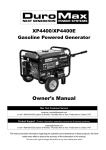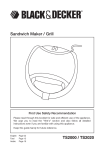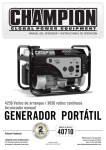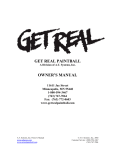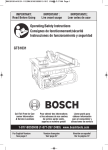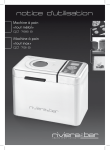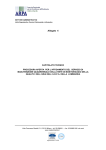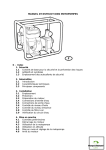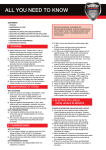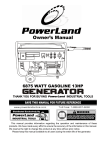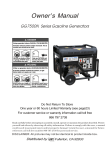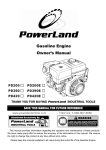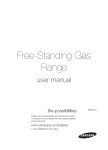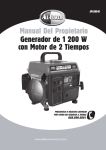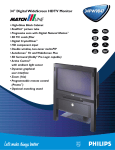Download Gasoline Water Pump Owner`s Manual
Transcript
Gasoline Water Pump Owner’s Manual Max Tool Customer Service [email protected] or call 1-800-629-3325 (option 3) Monday -Thursday 6am to 7pm, Friday - Saturday 6am to 3pm. PST Product Support (Product: information, application & warranty questions) [email protected] or call 1-800-629-3325 (option 3) Monday -Thursday 6am to 7pm, Friday - Saturday 6am to 3pm. PST This manual provides information regarding the operation and maintenance of these products. We have made every effort to ensure the accuracy of the information in this manual. We reserve the right to change this product at any time without prior notice. Please keep this manual available to all users during the entire life of the gasoline water pump. CONTENTS ĉ. General Safeguards ĂĂĂĂĂĂĂĂĂĂĂĂĂĂĂĂĂ 1 Ċ. Location of Component Parts ĂĂĂĂĂĂĂĂĂĂĂĂĂ 3 ċ. Operation before Starting Up ĂĂĂĂĂĂĂĂĂĂĂĂĂ 4 Č. Starting of Engine ĂĂĂĂĂĂĂĂĂĂĂĂĂĂĂĂĂĂ 9 č. Use in Highland Areas ĂĂĂĂĂĂĂĂĂĂĂĂĂĂĂĂ 11 Ď. Operation of Water Pump ĂĂĂĂĂĂĂĂĂĂĂĂĂĂ 12 ď. Shutting Down the Engine ĂĂĂĂĂĂĂĂĂĂĂĂĂĂ 13 Đ. Maintenance ĂĂĂĂĂĂĂĂĂĂĂĂĂĂĂĂĂĂĂĂ 14 đ. Transportation and Storage ĂĂĂĂĂĂĂĂĂĂĂĂĂĂ 19 Ē. Troubleshooting ĂĂĂĂĂĂĂĂĂĂĂĂĂĂĂĂĂĂĂ 21 ē. Specifications ĂĂĂĂĂĂĂĂĂĂĂĂĂĂĂĂĂĂĂĂ 23 ĉ. General Safeguards Safety Precautions Please read this operation manual to have a thorough understanding of the content there before use the product. Failure to do so may lead to personal injury or mechanical damage. Before starting the engine, perform inspections according to the procedures described on pre-operation inspections to avoid accidents and damage to your machine. For safety, never attempt using this GEP (gasoline engine powered) water pump to deliver inflammable or corrosive liquids (such as gasoline and acids). Likewise, corrosive mediums, seawater, chemical solvents, alkaline liquids (such as used gasoline, liquor and honey) should be avoided. Place the water pump on a solid, level position surface to avoid tilting or turnover that may give rise to spilling of fuel. To prevent fire hazards, keep the pump well ventilated during operation and maintain a distance of at least l meter between the machine and the wall or other machines. Keep away from inflammable substances. Do not allow children and pets to enter the working area as this may increase the chance of their getting burned by hot surfaces of the operating parts. Know how to stop the water pump quickly how to operate the controls. Do not use the pump against the prescribed operating rules. WARNING˖ Safety Precautions The gasoline fuel is highly inflammable and may explode under certain conditions. Do the fueling with the engine shut down and in a well-ventilated environment. No smoking is allowed and no open fire or sparks allowed to exist in areas where fueling is carried out or the fuel is stored. Do not allow the fuel to overflow the fuel tank. Be sure to recap the tank and tighten it after refueling. When fueling, take care not to spill the gasoline about as the gasoline vapor may easily get ignited to cause a fire hazard. Be sure to remove the spilled gasoline as by wiping before starting the engine. Do not run the engine indoors or in a poorly ventilated space as the exhaust gas produced by the running engine contains toxic carbon monoxide that may cause the loss of personal consciousness or even death. Ċ. Location of Component Parts ċ. Operation before Starting Up 1. Connecting the water inlet Connect the water inlet with a commercially available hose, connector and fastener clip. The inlet hose must be a continuous non-foldable structure with a length not more than required and should be placed near to the source of water so as to achieve the pump should be fitted to the end of the hose with the hose connector as shown in the figure below. CAUTION: Before pumping water, attach the filter to the end of the hose to filter out foreign matters in the water, the presence of which may cause clogging and damage to the wane wheel. NOTE: The hose connector and fastener clip should be securely fastened to prevent air leaks and reduction in suction power. A loose hose will reduce the pump performance and self-suction capacity. 2. Connecting the water outlet Connect the water outlet with a commercially available hose, hose connector and fastener clip. Large diameter hoses are the most effective while small ones will increase the flow resistance and reduce the output power of the pump. NOTE: Be sure to the fastener clip is securely fastened to prevent the outlet hose from coming off under high water pressure. 3.Checking the oil level CAUTION: gThe oil is one of the major factors affecting engine performance and life. Do not use dirty oil or vegetable oil. gBe sure to check the oil level with the engine shut down and placed on a level surface. Please use the SE15-40, 4-stroke engine oil as recommended. Please use the type of oil with a proper viscosity according to the local average temperature. Oil shortage alarm system (OSAS) (installation position) The OSAS is designed to avoid damage of the engine due to the shortage of oil in the crankcase. The system will automatically shut down the engine just before the crankcase oil level drops down to the minimum line of safety (with the engine switch staying in the ON position). If the engine is shut down and cannot be started again, check the oil level before initiating further troubleshooting procedures. Remove the oil dipstick and wipe it dry. Insert the dipstick into the oil filler but not screw it in. Replenish the crankcase with the recommended type of oil until the oil level comes up to the upper most position of the refilled if the existing oil level is found too low. CAUTON: gRunning the engine at a low oil level will cause damage to it. 4. Checking the fuel level Uncap the fuel tank and check the fuel level. Pouring gasoline if the fuel level is found too low. Please use the type of gasoline recommended by the Dealer (Using the low lead content or lead-free gasoline type is good for minimizing carbon deposits inside the combustion chamber). Do not use a mixture of gasoline and oil or dirty gasoline to prevent dirt, dust or water from entering the fuel tank. CAUTION: gThe gasoline fuel is highly inflammable and may explode under certain conditions. gDo the fueling with the engine shut down and in a well-ventilated environment. No smoking is allowed and no open fire or sparks allowed to exist in areas where fueling is carried out or the fuel is stored. gDo not allow the fuel to overflow the fuel tank. Be sure to recap the tank and tighten it after refueling. gWhen fueling, take care not to spill the gasoline about as the gasoline vapor may easily get ignited to cause a fire hazard. Be sure to remove the spilled gasoline as by wiping before starting the engine. gAvoid frequent or extensive exposure of the skin to gasoline or breathing in the gasoline vapor. Keep the gasoline out of the reach of children. gFuel tank capacity: 1.0 gallons (US. 3.6 liters) 5. Checking the air cleaner filter element Screw the wing nut and remove the washer and cleaner cover. Check the filter element to see if it is too dirty and clean it if necessary. CAUTION: Do not run the engine without the air cleaner as this may quicken engine wear if dirt or dust is sucked into the engine through the carburetor. 6. Checking and filling the pump with cooling water The pump must be filled with water before it is put to operation. CAUTION: gDo not attempt running the pump without cooling water or the pump will get overheated. Extensive running without cooling water may also damage the air tightness of the pump. If the pump is found running dry, stop the engine and pouring in water when it cools down. Č. Starting engine 1. Turn on the fuel tap (by setting it to the ON position). 2. Close the choke. NOTE: gThe choke is not required when starting the engine warm or the ambient temperature is rather high, (i.e. keep the choke open when starting the engine). 3. Set the engine switch to the ON position. 4. Turn the throttle control lever slowly to the left. 5. Gently pull up the starter lever until a resistance is felt and then quickly pull it up. CAUTION: gDo not allow the starter lever to retract quickly into the engine. Let it go back gently to avoid damaging the starter. č.Use in Highland Areas Operation in Highland Conditions In highland areas (with a high ASL elevation), the air-fuel mixture produced by a standard carburetor will be too thick and result in a reduced engine performance and soared fuel consumption. For operation in highland areas, the engine performance may be increased by using a smaller diameter carburetor nozzle and readjusting the carburetor idle speed. If the water pump is frequently used in areas with a ASL elevation of more than 1800 meters (6000 feet), ask the local dealer to replace or readjust the carburetor beforehand. Even if the engine is fitted with a carburetor nozzle of an appropriate size, the engine power will still go down by about 3.5% each time when the ASL elevation goes up by 305 meters (1000 feet). If no replacement or readjustment is ever made of the carburetor, the highland effect of the engine output power will be even more obvious. CAUTION: gUsing the water pump in areas where the ASL elevation is lower than suitable for the carburetor nozzle will lead to a decreased engine performance and overheating of the engine and even cause serious damage to the engine due to an extremely thin air-fuel mixture. Ď. Operation of the Water Pump 1. Gradually open the choke after the engine warms up. 2. Set the throttle to the predetermined RPM. ď. Shutting Down the Engine 1. Set the throttle control lever to the right end. 2. Set the engine switch to the OFF position. 3. Turn off the fuel tap (by setting to the OFF position). NOTE: gTo shut down the engine in an emergency, simply set the engine switch to the OFF position. Đ. Maintenance Periodic inspections and fine-tuning are simply indispensable to keep the water pump working with high performance and regular maintenance may also lengthen the pump life. Supplied in the table on the next page are intervals at which the schedules maintenance jobs are to be done. WARNING: gBefore any maintenance attempt, be sure to shut down the engine. If the maintenance job has to be done with the engine at work, it should take place in a well-ventilated space as the exhaust gas contains toxic carbon monoxide that causes the loss of personal consciousness or even death. CAUTION: gIn cases when the pump is used to suck up seawater, be sure to flush it with fresh water immediately after use to minimize corrosion and remove deposits. gAlways use the original parts and relevant tools supplied with the machine to carry out maintenance. Failure to do this may cause damage to the pump. NOTE: Ł Inspection and maintenance should take place more frequently if the pump is used in a dirty environment. ł Leave the following inspection and maintenance jobs to the authorized dealers unless you, the user, have the relevant tools and necessary DIY skills. In the latter case, refer to service manual. Table of Maintenance Schedules Normal Each Per Per Per maintenance time month month month Item perio or 20 or 50 or 100 d hours hours hours Per month or 300 hours ƻ Check engine oil lever ƻ ƻ Replace engine oil lever ƻ Air cleaner check Air cleaner for clean ƻ Spark plug Fuel supply Replace per every two years Wane wheel Pump case cover Water inlet Note: “*” items will be maintained with the help of dealers general power machinery Co., Ltd. 1. Replacing the engine oil Oil drains easily and quickly while the engine is warm. 1. Remove the oil dipstick and drain bolt to let out the oil. 2. Screw the drain bolt back in place and tighten it. 3. Pour in clean oil until the desired level is reached. Oil sump capacity: 0.6 liters Clean the hands with soap if stained with the engine oil. ƻ* ƻ* ƻ* ƻ* from NOTE: Be sure to keep the environment clean when disposing used engine oil. We suggest you collect the waste oil in a container to be sent to a waste disposal site or a recycling service center of spill it in the garbage or on the ground. 2. Maintaining the air cleaner A dirty air cleaner will let less air into the carburetor. To prevent carburetor malfunctions, be sure to maintain the air cleaner periodically. More frequent maintenance of the air cleaner will be necessary if the pump is working in an extremely dirty environment. DO not clean the air cleaner with a low ignition point solvent because it may get enflamed or even explode under certain circumstances. CAUTION: Do not use the water pump without an air cleaner. The dirt or dust if sucked into the engine may quicken engine wear. 1) Unscrew the wing nut and remove the air cleaner cover and filter element. 2) Clean the filter element with a detergent solution inflammable or with a high ignition point and let it dry thoroughly after cleaning. 3) Immerse the filter element into clean oil and then squeeze out the excessive amount of oil. 4) Put the filter element as well as the air cleaner back in place. 3. Maintaining the spark plug The recommended type of spark plug is NHSP LD P6RTCU. To ensure normal operation of the engine, the spark plug should have a correct gap and should remain free of carbon deposits. 1) Remove the plug cap. The muffler may be very hot if the engine is still running. Take care not to touch the muffler. 2) Check the spark plug visually. Discard the spark plug if it is obviously worn out or the insulation ring on it is broken or cracked. Clean the spark plug with a brush when put it back in place. 3) Check the plug gap with a feeler gauge. Vary the gap by moving the side electrode. Normal plug gap: 0.70~0.80mm 4) Check the plug O-ring for normal condition. Screw it in with the plug wrench to protect the plug thread. NOTE: gIn the case of screwing in a new spark plug, tighten it by an additional 1/2 screw turn after the plug reaches and pushes on the O-ring, while in the case of a used spark plug, an additional 1/2~1/4 screw turn is necessary. CAUTION: g Make sure the spark plug is properly tightened. Improper tightening may cause the engine to be overheated or damaged. Never use spark plugs with an incorrect thermal value range. đ. Transportation and Storage CAUTION: gTo avoid causing a fire hazard, let the engine cool down before transportation or indoor storage of the pump. gBefore transporting the pump, set the fuel tap to the OFF position and place the pump body in a level position to prevent the fuel from spilling out. The spilled gasoline or the gasoline vapor may get ignited. Note and do the following before storing pump for an extended period of time: 1) Make sure the storage area is free of moisture or dust. 2) Ch\lean the inside of the pump. The pump may get clogged if it is used to suck up water containing such matters as earth, sand or heavy fragments. Before storing, clean the pump by sucking up clean water or otherwise the wane wheel may be damaged when the pump is put to use again. After cleaning, unscrew the water drain plug to drain off the water from inside the pump casing as much as possible. Then screw the drain plug back into place. 3) Drain off the fuel. a. Turn off the fuel tap (OFF position), unscrew the drain screw from the carburetor float chamber to drain off the fuel from inside the carburetor and collect the gasoline in a suitable container. b. Turn on the fuel tap (ON position) and collect the gasoline in a suitable container. c. Screw the carburetor fuel drain screw back into place. 4) Replace the engine oil. 5) Screw off the spark plug, pour a spoonful of clean oil into the cylinder, turn the engine alternatively for several times to allow uniform distribution of oil, and then screw in the spark plug again. 6) Pull up the starter lever until a resistance is felt. Stop pull for a while and pull it up again until the triangle mark on the starter wheel gets into collimation with the screw hole in the starter (as shown the sketch below). In this position, both the inlet valve and outlet valve is closed to prevent corrosion inside the engine. 7) Cover up the pump to keep out dust. Ē. Troubleshooting Engine unable to get started: 1) Is there enough fuel? 2) Is the fuel tap turned on? 3) Has the fuel reached the carburetor? Make the check by unscrewing the oil drain screw from under the carburetor with the fuel tap turned on. WARNING: gShould there be a spill of fuel, be sure to clean it before checking the spark plug and start the engine or otherwise the spilled fuel or fuel vapor may get ignited 4) Is the engine switch set to the ON position? 5) Is there enough oil in the crankcase? 6) Is the spark plug generating sparks? a. Uncap the spark plug, clear off the dirt from around the plug and remove the spark plug. b. Fit the spark plug into the plug cap. c. Turn on the engine with the side electrode and pull up the starter lever to see if there is sparks generated. d. Ground the engine with the side electrode and pull up the starter lever to see if there is sparks generated. e. Replace the spark plug if no spark is found. Start the engine as directed in the operation manual if sparks are generated. 7) If the engine still refuses to get started, send the pump to any of the authorized dealers. The pump unable to such up water: 1) Is it filled with enough amount of water? 2) Is the filter clogged? 3) Is the hose fastener clip tightened? 4) Is the hose damaged? 5) Is the suction head too high? 6) If the pump still fails to work, send it to any of the authorized dealers. ē. Specifications Type XP652WP XP650WP XP904WP Engine type XP6.5HP XP6.5HP XP9.0HP Max. Power 4.7kw(6.5HP) 4.7kw(6.5HP) 6.5kw(9.0HP) 196cc 196cc 270cc 1.0 Gallons 1.0 Gallons 1.7 Gallons 0.63 US. Qt. (0.6L, 20fl oz.) 0.63 US. Qt. (0.6L, 20fl oz.) Displacement Fuel tank capacity Oil capacity 1.16 US. Qt (1.1L, 37fl oz.) Water intake pipe dia. 2ą 3ą 4ą Water output pipe dia. 2ą 3ą 4ą 3600rpm 3600rpm 3600rpm Max. overhead lift 92ft 98ft 98ft Max. suction lift 26ft 26ft 26ft 158 GPM 220 GPM 427 GPM 18.7h15.6h 15.4(in.) 21.3h17.5h 19.3(in.) 25.2h20.7h 22.3(in.) Revolution Max. flow rate Size PARTS LIST AND ASSEMBLY(XP652WP/XP650WP) Part 21100 GB5787-86 12302 12310 GB6177-86 19005 19001 81200 87500 12302 19002 19003 81100 GB5789-86 13203 12217 900008 12200 17300 GB5787-86 17316 Item 1 2 3 4 5 6 7 8 9 10 11 12 13 14 15 16 17 18 19 20 21 2 1 13 1 1 2 2 2 1 1 1 1 1 1 1 1 1 1 1 4 1 Qty Lever comp, choke Flange bolt M6×12 Carburetor assy. Crank case assy. Oil seal, 25×41×6 Washer, drain lug Bolt, drain lug Flange bolt M6×25 Coil assy. ignition Switch wire Plate, side Clip. Wire darkness Amplifier Flywheel comp Fan, cooling Pulley, starter Flange nut M14 Fan, cover comp Engine switch Flange bolt M6×8 Starter comp, recoil Description 42 41 40 39 38 37 36 35 34 33 32 31 30 29 28 27 26 25 24 23 22 Item 90007 91005 GB5789-86 90006 11240 16004 16001 16007 16002 GB6177-86 16003 GB5789-86 16005 92001 11250 90005 91004 90004 90003 90002 19003 Part 1 2 4 1 1 1 1 2 1 5 1 1 1 1 1 1 2 1 1 1 1 Qty Casket, cylinder head Bolt head, M8×32 Flange bolt M8×60 Exhaust piper Cover comp, head Cover comp, air cleaner Element, air cleaner Nut, M6 Separator, air cleaner Flange nut M6 Case comp, air cleaner Flange bolt M6×20 Seal, air cleaner Casket, muffler Head comp, cylinder Packing, insulator Bolt head, 6×112 Insulator, carburetor Packing, carburetor Packing air cleaner Shroud comp Description 92002 GB/T276-94 11202 15002 15001 11215 11214 GB/T 6170 18003 18002 11204 18001 18101 11206 11205 11211 11216 11208 15100 11209 11206 11212 43 44 45 46 47 48 49 53 54 55 50 51 52 56 57 58 59 60 61 62 63 64 1 2 1 1 1 1 1 2 2 1 1 2 1 1 2 2 1 2 2 1 2 2 Retainer, EX. Valve spring Spring, valve Valve, EX. Camshaft assy. Valve, IN. Seat, valve spring Retainer, IN. Valve spring Arm, valve rocker Nut, pivot adjusting Casket EX. Pipe Muffler Nut, Arm, valve rocker Protector, muffler Arrester, spark Nut, M8 Bolt, pivot Plate, push rod guide Rod, push Lifter, valve Plug, spark Radial ball bearing (6025 Pin, dowel, 10×16 86 85 84 83 82 81 80 79 78 77 76 75 74 73 72 71 70 69 68 67 66 65 17002 91003 17001 12230 87400 GB5789-86 13000 GB/T 99-88 17200 90001 92003 12102 GB5789-86 12100 12103 13101 13100 GB847-85 13104 13015 13106 11213 1 1 1 1 1 2 1 1 1 1 2 1 6 1 1 1 1 5 1 2 1 1 Spring, throttle return Bolt, governor arm Spring, governor Governor assy. Switch assy. oil level Flange bolt M6×12 Crankshaft comp Key, 25×18 Control assy. Packing, case cover Pin, dowel, 8×14 Cap assy. oil filler Flange bolt M8×32 Crankcase cover Cap, oil hole Piston Ping set, piston Screw, tapping M5×8 Pin, piston Clip, piston pin Connecting rod assy. Rotator, valve 17004 17003 91009 12208 17102 91002 87 88 89 90 91 92 2 1 1 1 1 1 Clip, tube Rubber, supporter Shaft, governor assy. Tube, fuel Rod, governor Arm, governor 97 96 95 94 93 17110 17130 17120 17101 GB5789-86 1 1 1 1 1 Fuel filler cap Filter, fuel Tank fuel Joint, fuel tank Flange bolt M6×30 Part TS1300 TS1301 GB5787-86 TS1006 TS1303 TS1101 TS1100 TS1008 TS1103 TS1001 GB5787-86 TS1013 TS1012 TS1003 Item 98 99 100 101 102 103 104 105 106 107 108 109 110 111 1 2 2 12 1 1 1 1 1 1 1 4 4 1 Qty Flapper valve gasket Plug 124 123 122 Flange Bolt M8×25 (XP652WP) Flange Bolt M10×25 (XP650WP) O-ring, Plug 121 120 119 118 117 116 115 114 113 112 Item Pump case housing Ring, Volute casing Volute casing Impeller, water pump Mechanical seal B Mechanical seal A O-Ring, water pump Flange Bolt M8×53 Washer Assembly, pump cover Description GB5787-86 TS2111 GB5789-86 GB6177-86 TS4100 TS2030 TS2020 TS1004 TS1005 TS2003 TS2002 TS2001 TS1002 Part 4 4 4 4 1 1 3 1 1 2 2 2 1 Qty Flange Bolt M6×16 Rubber pad, damping Flange bolt M8×35 Flange nut M8 Frame Strainer Hose Band Discharge port Discharge gasket Hose Coupling Hose Joint Coupling Packing Suction port Description PARTS LIST AND ASSEMBLY(XP904WP) 3 1 GB5787-86 11082 12310 GB5787-86 19003 19005 19001 GB6177-86 23007 81200 12215 12200 12203 87500 12217 87601 GB5789-86 81100 81103 2 3 4 5 6 7 8 9 10 11 12 13 14 15 16 17 18 19 20 1 1 2 1 2 1 2 1 2 1 1 1 1 1 1 12 1 1 21100 1 Qty Part Item Grommet cord Coil assy. ignition Flange bolt M6×25 Clip, wire Washer, drain lug Amplifier Bolt, drain lug Crank case assy. Oil seal, 35×52×8 Flywheel comp Clip. Wire harness Flange nut M16 Fan, cooling Pulley, starter Shroud comp Flange bolt M6×12 Fan, cover comp Engine switch Flange bolt M6×8 Starter comp, recoil Description 40 39 38 37 36 35 34 33 32 31 30 29 28 27 26 25 24 23 22 21 Item 23000 23002 23001 23003 11218 12220 11219 GB/T276-94 GB/T 99-88 13000 13200 12200 12221 GB6177-86 12209 12212 12208 GB/T276-94 12216 81102 Part 1 1 1 1 2 2 1 2 1 1 1 1 1 1 1 1 1 2 1 Qty Carburetor assy. Packing, carburetor Insulator, carburetor Packing, insulator Bolt head, 8×111 Pin, dowel, 12×20 Casket, cylinder head Radial ball bearing (6207) Key Crankshaft comp Weight, balancer Switch assy. oil level O-ring, 14mm Flange nut M10 Washer, 8.2×17×0.8 Pin, lock, 10mm Shaft, governor arm Radial ball bearing (6202) Oil seal, 8×14×5 Cord stop switch Description 22000 23008 GB6177-86 12005 GB5789-86 12010 16007 16008 12010 12004 12007 11242 11243 11240 11241 GB5789-86 12001 11250 11217 11202 15100 15002 41 42 43 44 45 46 47 48 49 50 51 52 53 54 55 56 57 58 59 60 61 62 2 1 1 2 1 1 4 1 1 1 1 1 1 1 2 2 1 1 1 5 2 1 Lifter, valve Camshaft assy. Plug, spark Bolt head, M8×34 Head comp, cylinder Tube, breather Flange bolt M10×80 Exhaust piper Cover comp, head Washer comp head cover Bolt, head cover Cover comp, air cleaner Separator, air cleaner Element assy. air cleaner Washer, drain lug Nut, M6 Seal, air cleaner Flange bolt M6×20 Case comp, air cleaner Flange nut M6 Packing, air cleaner Stay manual choke 84 83 GB5789-86 GB847-85 13030 82 7 5 1 1 13020 81 1 13010 1 1 1 6 2 2 2 1 1 2 1 1 2 1 2 1 1 13200 13202 GB6177-86 11206 11204 11205 11212 11213 11214 11215 11211 11206 11216 15001 11209 11208 13003 80 79 78 77 76 75 74 73 72 71 70 69 68 67 66 65 64 63 Flange bolt M8×35 Screw, tapping M5×8 Muffler guard Muffler Arrester, spark Muffler stay Pipe comp EX. Casket (B) EX. Pipe Flange nut M8 Nut, pivot adjusting Nut, Arm, valve rocker Arm, valve rocker Retainer, EX. Valve spring Rotator, valve Bolt, pivot Plate, push rod guide Retainer, IN. Valve spring Spring, valve Seat, valve spring Rod, push Valve, EX. Valve, IN. 12103 12100 12214 12213 121102 12230 13105 13104 13100 13101 13106 17220 17001 85 86 87 88 89 90 91 92 93 94 95 96 97 1 1 1 1 1 1 2 1 1 2 1 1 1 Spring, governor Control assy. Connecting rod assy. Piston Ping set assy. piston Pin, piston Clip, piston pin Governor kit Cap assy. oil filler Pin, dowel, 8×12 Packing, case cover Crankcase cover Cap, oil hole 109 108 107 106 105 104 103 102 101 100 99 98 1 14004 1 1 1 17102 14302 14300 1 1 14100 17101 1 14102 2 1 14200 GB5789-86 1 1 1 17004 17005 17002 Fuel filler cap comp Fuel filter Rubber joint, fuel tank Joint, fuel tank Outlet pipeij4.5×235 Fuel cock Rubber, supporter Flange bolt M8×25 Fuel tank Arm, governor Bolt, governor arm Spring, throttle return Part TS1300 TS1301 GB5787-86 TS1006 TS1303 TS1101 TS1100 TS1008 TS1103 TS1001 GB5787-86 TS1013 TS1012 TS1003 Item 109 110 111 112 113 114 115 116 117 118 119 120 121 122 1 2 2 12 1 1 1 1 1 1 1 4 4 1 Qty Flapper valve gasket Plug O-ring, Plug Flange Bolt M10×25 Pump case housing Ring, Volute casing Volute casing Impeller, water pump Mechanical seal B Mechanical seal A O-Ring, water pump Flange Bolt M8×45 Washer Assembly, pump cover Description 135 134 133 132 131 130 129 128 127 126 125 124 123 Item GB5787-86 TS2111 GB5789-86 GB6177-86 TS4100 TS2030 TS2020 TS1004 TS1005 TS2003 TS2002 TS2001 TS1002 Part 4 4 4 4 1 1 3 1 1 2 2 2 1 Qty Flange Bolt M6×16 Rubber pad, damping Flange bolt M10×35 Flange nut M10 Frame Strainer Hose Band Discharge port Discharge gasket Hose Coupling Hose Joint Coupling Packing Suction port Description
































